Unit8 How do you make a banana milk shake? Section A 1a-3b 知识点串讲课件(共15张PPT)
文档属性
| 名称 | Unit8 How do you make a banana milk shake? Section A 1a-3b 知识点串讲课件(共15张PPT) | 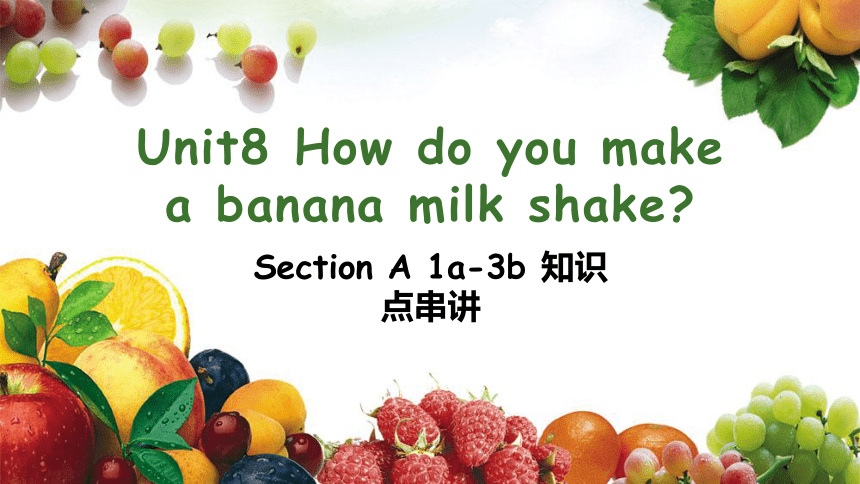 | |
| 格式 | zip | ||
| 文件大小 | 818.7KB | ||
| 资源类型 | 教案 | ||
| 版本资源 | 人教新目标(Go for it)版 | ||
| 科目 | 英语 | ||
| 更新时间 | 2022-10-10 15:37:31 | ||
图片预览

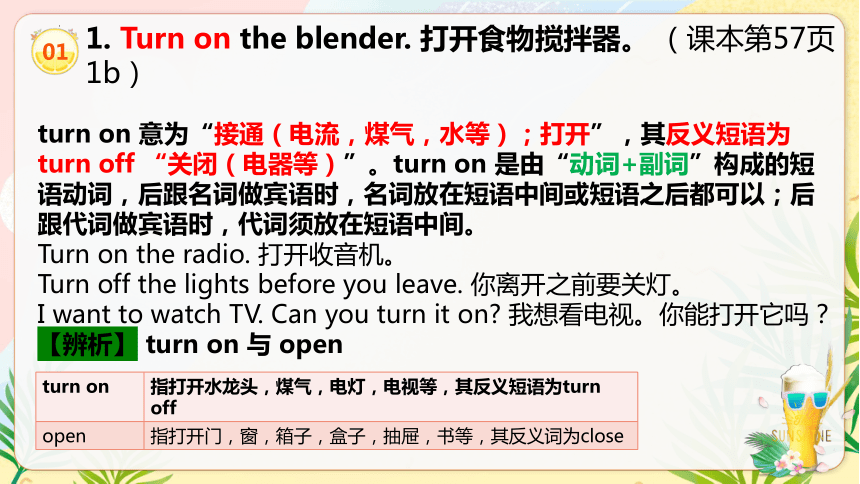
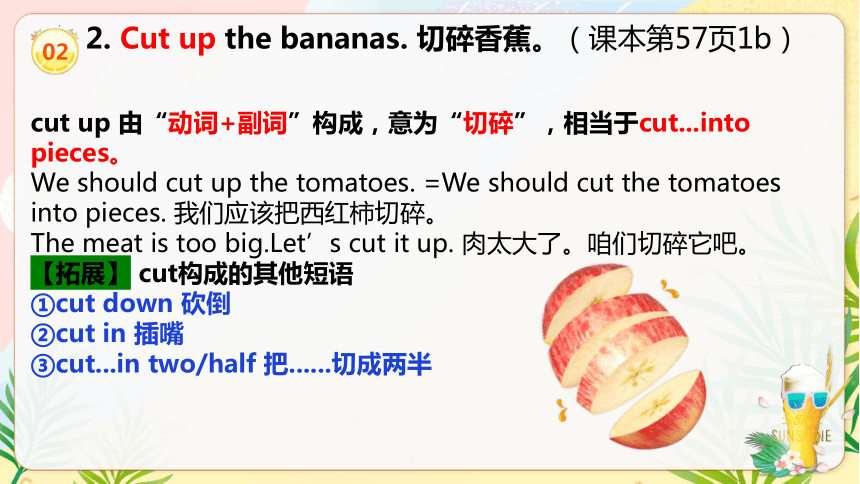
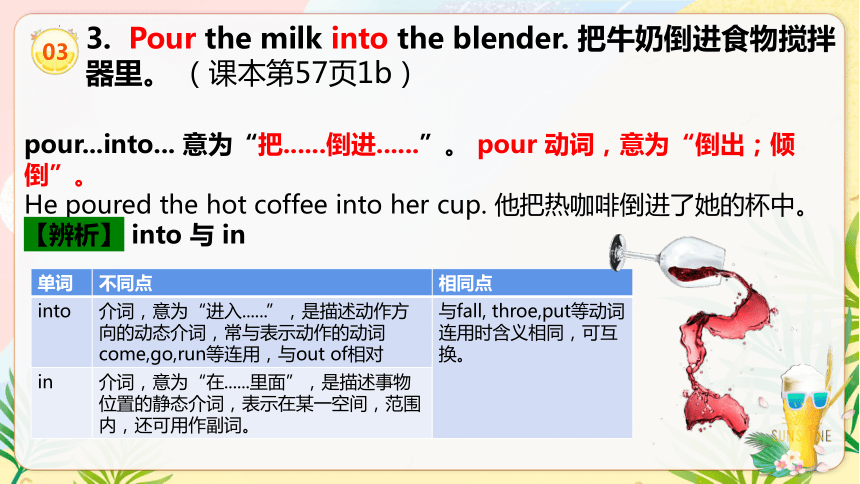
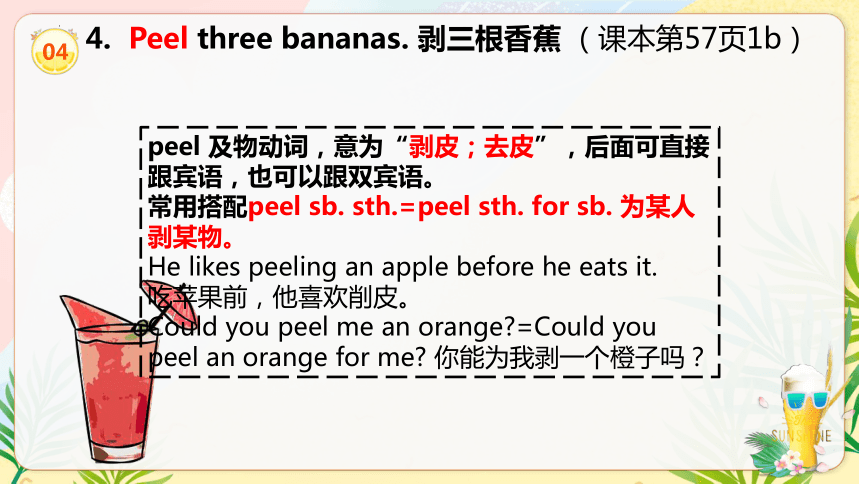
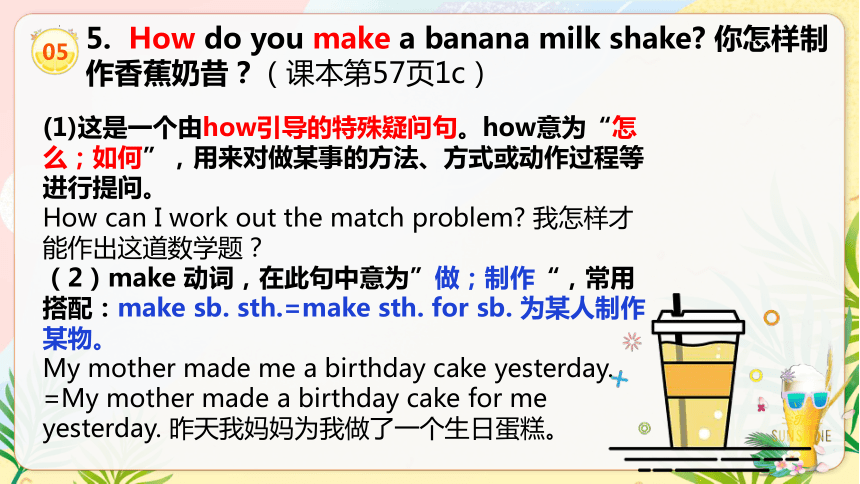
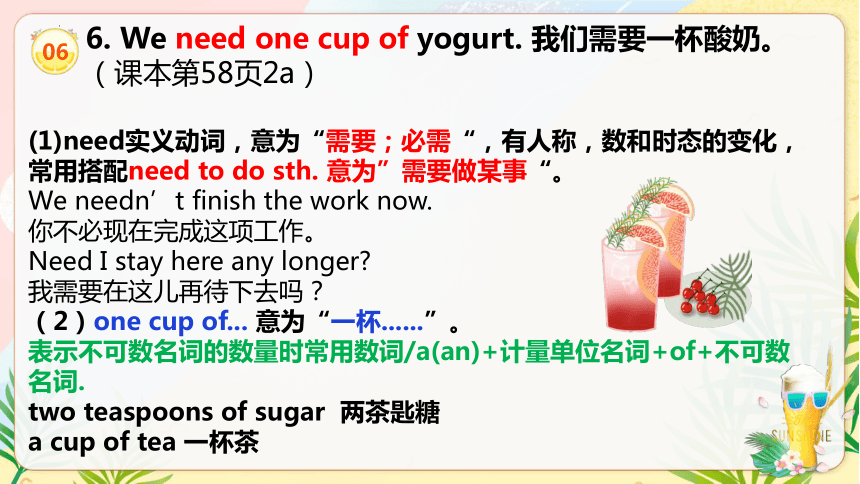
文档简介
(共15张PPT)
Unit8 How do you make a banana milk shake
Section A 1a-3b 知识点串讲
01
1. Turn on the blender. 打开食物搅拌器。 (课本第57页1b)
turn on 意为“接通(电流,煤气,水等);打开”,其反义短语为turn off “关闭(电器等)”。turn on 是由“动词+副词”构成的短语动词,后跟名词做宾语时,名词放在短语中间或短语之后都可以;后跟代词做宾语时,代词须放在短语中间。
Turn on the radio. 打开收音机。
Turn off the lights before you leave. 你离开之前要关灯。
I want to watch TV. Can you turn it on 我想看电视。你能打开它吗?
【辨析】 turn on 与 open
turn on 指打开水龙头,煤气,电灯,电视等,其反义短语为turn off
open 指打开门,窗,箱子,盒子,抽屉,书等,其反义词为close
02
2. Cut up the bananas. 切碎香蕉。(课本第57页1b)
cut up 由“动词+副词”构成,意为“切碎”,相当于cut...into pieces。
We should cut up the tomatoes. =We should cut the tomatoes into pieces. 我们应该把西红柿切碎。
The meat is too big.Let’s cut it up. 肉太大了。咱们切碎它吧。
【拓展】 cut构成的其他短语
①cut down 砍倒
②cut in 插嘴
③cut...in two/half 把......切成两半
03
3. Pour the milk into the blender. 把牛奶倒进食物搅拌器里。 (课本第57页1b)
pour...into... 意为“把......倒进......”。 pour 动词,意为“倒出;倾倒”。
He poured the hot coffee into her cup. 他把热咖啡倒进了她的杯中。
【辨析】 into 与 in
单词 不同点 相同点
into 介词,意为“进入......”,是描述动作方向的动态介词,常与表示动作的动词come,go,run等连用,与out of相对 与fall, throe,put等动词连用时含义相同,可互换。
in 介词,意为“在......里面”,是描述事物位置的静态介词,表示在某一空间,范围内,还可用作副词。
04
4. Peel three bananas. 剥三根香蕉 (课本第57页1b)
peel 及物动词,意为“剥皮;去皮”,后面可直接跟宾语,也可以跟双宾语。
常用搭配peel sb. sth.=peel sth. for sb. 为某人剥某物。
He likes peeling an apple before he eats it.
吃苹果前,他喜欢削皮。
Could you peel me an orange =Could you peel an orange for me 你能为我剥一个橙子吗?
05
5. How do you make a banana milk shake 你怎样制作香蕉奶昔?(课本第57页1c)
(1)这是一个由how引导的特殊疑问句。how意为“怎么;如何”,用来对做某事的方法、方式或动作过程等进行提问。
How can I work out the match problem 我怎样才能作出这道数学题?
(2)make 动词,在此句中意为”做;制作“,常用搭配:make sb. sth.=make sth. for sb. 为某人制作某物。
My mother made me a birthday cake yesterday. =My mother made a birthday cake for me yesterday. 昨天我妈妈为我做了一个生日蛋糕。
06
6. We need one cup of yogurt. 我们需要一杯酸奶。(课本第58页2a)
(1)need实义动词,意为“需要;必需“,有人称,数和时态的变化,常用搭配need to do sth. 意为”需要做某事“。
We needn’t finish the work now.
你不必现在完成这项工作。
Need I stay here any longer
我需要在这儿再待下去吗?
(2)one cup of... 意为“一杯......”。
表示不可数名词的数量时常用数词/a(an)+计量单位名词+of+不可数名词.
two teaspoons of sugar 两茶匙糖
a cup of tea 一杯茶
07
7. —Let’s make fruit salad. 咱们做水果沙拉吧。
—OK,good idea. 好的,好主意。(课本第58页2c)
(1)let使役动词,后接动词原形作宾语补足语,即let sb. do sth. ,意为“让某人做某事”。
Let Li Ying do it. 让李英做这件事吧。
【辨析】let’s 与let us
Let’s start early,shall we 我们早点儿动身,好吗?
Let us have a try,will you 让我们试一试,好吗?
(2)good idea 意为“好主意”,常用来表示对说话人所提的建议表示赞同,也可以说“That’s a good idea.”。
—Let’s make kites together. 让我们一块儿制作风筝吧。
—Good idea. 好主意。
let’s 表示向对方提建议,包括说话者和对方在内
let us 表示请求对方允许做某事,不包括对方
08
8. First,buy some beef,one cabbage,four carrots,three potatoes,five tomatoes and one onion. 首先,买一些牛肉,一颗卷心菜,四个胡萝卜,三个土豆,五个西红柿和一个洋葱。(课本第58页2d)
first此处用作副词,意为“首先”,可用于句首或句末。
You must finish your homework first. 首先,你必须完成作业。
【拓展】
①first还可用作序数词,常与定冠词the连用,意为“第一”。
January is the first month of the year. 一月是一年里的第一个月。
②first 构成的常用短语:
at first 起初,首先 first at all 首先
first or last 迟早 from first to last 自始至终
09
9. Next,put the beef,carrots and potatoes into a pot and add some water. 接下来,把牛肉、胡萝卜和土豆放进锅里并加一些水。(课本第58页2a)
(1)next 此处用作副词,意为“接下来”,还可意为“其次‘,位置灵活。
I like English best,and math next. 我最喜欢英语,其次是数学。
(2)add此处用作及物动词,意为“增加”。常用结构add...to...意为“把......添加到......”,本句省略了to the pot。
The pot is full; don’t add more water. 锅满了,不要再加水了。
She added sugar to her coffee. 她在她的咖啡里加了糖。
【拓展】add相关的其他用法
add to 增加,增添
add up to 加起来等于;总计达
10
10. OK,that’s it? 好的,这就结束了? (课本第58页2d)
that’s it 是一个固定的口语表达方式,此处用于表示某事了结,停止,结束等,意为“完了;就这样;没别的了”。
That’s it;I don’t like you any more,and I don’t want to see you again.
就这样,我不再喜欢你了,我也不想再见到你。
You can have a cake and that’s it.
你可以吃一个蛋糕,别的就没有了。
11
11. Finally,don’t forget to add some salt. 最后,不要忘记加一些盐。(课本第58页2d)
finally 副词,意为“最后;最终”,通常与first,next,then连用,表示一个过程的先后顺序,可位于句首,句中或句末。其近义词组为at last和in the end。
After traveling by train for three days,we finally got home.
坐了三天火车,我们最后到家了。
Finally,I worked out the problem.
我最后作出了那道题。
12
12. Half a cup. 半杯。 (课本第59页3b)
half 常用的含义为:一半...... half a/an...
【拓展】
half也可修饰可数名词复数或不可数名词,做主语时,谓语动词的单复数形式由half所接的名词决定。
Half the apples are bad
这些苹果中有一半是坏的。
Half the milk comes from the farm.
一半的牛奶来自这家牧场。
13
13. Do you know how to plant a tree 你知道怎么植树吗?(课本第59页3c)
how to plant a tree 为“特殊疑问词+动词不定式”结构,在句中作know的宾语。不定式可以和what,where等疑问词连用,构成不定式短语,在句中做主语,宾语,表语等。做主语时,谓语动词用单数形式。
Where to say for the night is a problem. 晚上在哪里过夜是个问题。
The young woman doesn’t know what to do. 那位年轻的女子不知道该做什么。
【拓展】
做宾语时,“特殊疑问词+动词不定式”=该疑问词引导的宾语从句。
Excuse me.Can you tell me how to get to the bookshop =Excuse me.Can you tell me how I can get to the bookshop 请问,你能告诉我怎么去那家书店吗?
Thank you
Unit8 How do you make a banana milk shake
Section A 1a-3b 知识点串讲
01
1. Turn on the blender. 打开食物搅拌器。 (课本第57页1b)
turn on 意为“接通(电流,煤气,水等);打开”,其反义短语为turn off “关闭(电器等)”。turn on 是由“动词+副词”构成的短语动词,后跟名词做宾语时,名词放在短语中间或短语之后都可以;后跟代词做宾语时,代词须放在短语中间。
Turn on the radio. 打开收音机。
Turn off the lights before you leave. 你离开之前要关灯。
I want to watch TV. Can you turn it on 我想看电视。你能打开它吗?
【辨析】 turn on 与 open
turn on 指打开水龙头,煤气,电灯,电视等,其反义短语为turn off
open 指打开门,窗,箱子,盒子,抽屉,书等,其反义词为close
02
2. Cut up the bananas. 切碎香蕉。(课本第57页1b)
cut up 由“动词+副词”构成,意为“切碎”,相当于cut...into pieces。
We should cut up the tomatoes. =We should cut the tomatoes into pieces. 我们应该把西红柿切碎。
The meat is too big.Let’s cut it up. 肉太大了。咱们切碎它吧。
【拓展】 cut构成的其他短语
①cut down 砍倒
②cut in 插嘴
③cut...in two/half 把......切成两半
03
3. Pour the milk into the blender. 把牛奶倒进食物搅拌器里。 (课本第57页1b)
pour...into... 意为“把......倒进......”。 pour 动词,意为“倒出;倾倒”。
He poured the hot coffee into her cup. 他把热咖啡倒进了她的杯中。
【辨析】 into 与 in
单词 不同点 相同点
into 介词,意为“进入......”,是描述动作方向的动态介词,常与表示动作的动词come,go,run等连用,与out of相对 与fall, throe,put等动词连用时含义相同,可互换。
in 介词,意为“在......里面”,是描述事物位置的静态介词,表示在某一空间,范围内,还可用作副词。
04
4. Peel three bananas. 剥三根香蕉 (课本第57页1b)
peel 及物动词,意为“剥皮;去皮”,后面可直接跟宾语,也可以跟双宾语。
常用搭配peel sb. sth.=peel sth. for sb. 为某人剥某物。
He likes peeling an apple before he eats it.
吃苹果前,他喜欢削皮。
Could you peel me an orange =Could you peel an orange for me 你能为我剥一个橙子吗?
05
5. How do you make a banana milk shake 你怎样制作香蕉奶昔?(课本第57页1c)
(1)这是一个由how引导的特殊疑问句。how意为“怎么;如何”,用来对做某事的方法、方式或动作过程等进行提问。
How can I work out the match problem 我怎样才能作出这道数学题?
(2)make 动词,在此句中意为”做;制作“,常用搭配:make sb. sth.=make sth. for sb. 为某人制作某物。
My mother made me a birthday cake yesterday. =My mother made a birthday cake for me yesterday. 昨天我妈妈为我做了一个生日蛋糕。
06
6. We need one cup of yogurt. 我们需要一杯酸奶。(课本第58页2a)
(1)need实义动词,意为“需要;必需“,有人称,数和时态的变化,常用搭配need to do sth. 意为”需要做某事“。
We needn’t finish the work now.
你不必现在完成这项工作。
Need I stay here any longer
我需要在这儿再待下去吗?
(2)one cup of... 意为“一杯......”。
表示不可数名词的数量时常用数词/a(an)+计量单位名词+of+不可数名词.
two teaspoons of sugar 两茶匙糖
a cup of tea 一杯茶
07
7. —Let’s make fruit salad. 咱们做水果沙拉吧。
—OK,good idea. 好的,好主意。(课本第58页2c)
(1)let使役动词,后接动词原形作宾语补足语,即let sb. do sth. ,意为“让某人做某事”。
Let Li Ying do it. 让李英做这件事吧。
【辨析】let’s 与let us
Let’s start early,shall we 我们早点儿动身,好吗?
Let us have a try,will you 让我们试一试,好吗?
(2)good idea 意为“好主意”,常用来表示对说话人所提的建议表示赞同,也可以说“That’s a good idea.”。
—Let’s make kites together. 让我们一块儿制作风筝吧。
—Good idea. 好主意。
let’s 表示向对方提建议,包括说话者和对方在内
let us 表示请求对方允许做某事,不包括对方
08
8. First,buy some beef,one cabbage,four carrots,three potatoes,five tomatoes and one onion. 首先,买一些牛肉,一颗卷心菜,四个胡萝卜,三个土豆,五个西红柿和一个洋葱。(课本第58页2d)
first此处用作副词,意为“首先”,可用于句首或句末。
You must finish your homework first. 首先,你必须完成作业。
【拓展】
①first还可用作序数词,常与定冠词the连用,意为“第一”。
January is the first month of the year. 一月是一年里的第一个月。
②first 构成的常用短语:
at first 起初,首先 first at all 首先
first or last 迟早 from first to last 自始至终
09
9. Next,put the beef,carrots and potatoes into a pot and add some water. 接下来,把牛肉、胡萝卜和土豆放进锅里并加一些水。(课本第58页2a)
(1)next 此处用作副词,意为“接下来”,还可意为“其次‘,位置灵活。
I like English best,and math next. 我最喜欢英语,其次是数学。
(2)add此处用作及物动词,意为“增加”。常用结构add...to...意为“把......添加到......”,本句省略了to the pot。
The pot is full; don’t add more water. 锅满了,不要再加水了。
She added sugar to her coffee. 她在她的咖啡里加了糖。
【拓展】add相关的其他用法
add to 增加,增添
add up to 加起来等于;总计达
10
10. OK,that’s it? 好的,这就结束了? (课本第58页2d)
that’s it 是一个固定的口语表达方式,此处用于表示某事了结,停止,结束等,意为“完了;就这样;没别的了”。
That’s it;I don’t like you any more,and I don’t want to see you again.
就这样,我不再喜欢你了,我也不想再见到你。
You can have a cake and that’s it.
你可以吃一个蛋糕,别的就没有了。
11
11. Finally,don’t forget to add some salt. 最后,不要忘记加一些盐。(课本第58页2d)
finally 副词,意为“最后;最终”,通常与first,next,then连用,表示一个过程的先后顺序,可位于句首,句中或句末。其近义词组为at last和in the end。
After traveling by train for three days,we finally got home.
坐了三天火车,我们最后到家了。
Finally,I worked out the problem.
我最后作出了那道题。
12
12. Half a cup. 半杯。 (课本第59页3b)
half 常用的含义为:一半...... half a/an...
【拓展】
half也可修饰可数名词复数或不可数名词,做主语时,谓语动词的单复数形式由half所接的名词决定。
Half the apples are bad
这些苹果中有一半是坏的。
Half the milk comes from the farm.
一半的牛奶来自这家牧场。
13
13. Do you know how to plant a tree 你知道怎么植树吗?(课本第59页3c)
how to plant a tree 为“特殊疑问词+动词不定式”结构,在句中作know的宾语。不定式可以和what,where等疑问词连用,构成不定式短语,在句中做主语,宾语,表语等。做主语时,谓语动词用单数形式。
Where to say for the night is a problem. 晚上在哪里过夜是个问题。
The young woman doesn’t know what to do. 那位年轻的女子不知道该做什么。
【拓展】
做宾语时,“特殊疑问词+动词不定式”=该疑问词引导的宾语从句。
Excuse me.Can you tell me how to get to the bookshop =Excuse me.Can you tell me how I can get to the bookshop 请问,你能告诉我怎么去那家书店吗?
Thank you
同课章节目录
- Unit 1 Where did you go on vacation?
- Section A
- Section B
- Unit 2 How often do you exercise?
- Section A
- Section B
- Unit 3 I'm more outgoing than my sister.
- Section A
- Section B
- Unit 4 What's the best movie theater?
- Section A
- Section B
- Unit 5 Do you want to watch a game show?
- Section A
- Section B
- Unit 6 I'm going to study computer science.
- Section A
- Section B
- Unit 7 Will people have robots?
- Section A
- Section B
- Unit 8 How do you make a banana milk shake?
- Section A
- Section B
- Unit 9 Can you come to my party?
- Section A
- Section B
- Unit 10 If you go to the party, you'll have a grea
- Section A
- Section B
